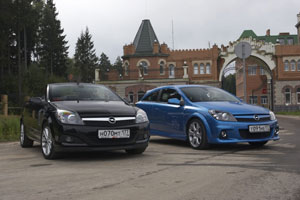Test drive Opel Astra Sedan 1998 - 2008 Sedan
Opel Astra N-Joy 1.8 /10 800 km
 Astra-universal car. In the sense that it is produced in different bodies and can be a caravan-saray, a three- or five-door hatchback, a compartment and even a convertible.
Astra-universal car. In the sense that it is produced in different bodies and can be a caravan-saray, a three- or five-door hatchback, a compartment and even a convertible. The sheds are historically not very popular; Bertone ASTRA cape, although they are sold in Russia unexpectedly even well, even for the ji-umovs themselves, but the account is still on a few; Convertibles are not officially delivered to us. So the basis of sales is sedans and hatchbacks. Moreover, the hatchbacks, according to dealers, are more interested in people than sedans. At first glance, it is strange, given the traditional love of Russians for cars with trunk. What is the matter? In money. Money is more expensive than love. The sedan costs $ 400 more than a five -door hatchback. More precisely, it cost until recently. Because - cheers! - Autumn has come, a new model year began. And Astra sedans fell to the level of five -door hatchbacks. O-la-la, we thought and took a silver sedan for comparison.
+/- The base of the sedan and hatchback is the same and very decent for golf class cars- 2606 mm. The machines salons are also identical - which is in size, which is in view of the driver's seat. But from the side the sedan looks more solid as a hatchback. It is longer than 14 cm. These additional centimeters went to the rear overhang - where the hatchback has a tail of the tail, the sedan has a trunk.
 The lugger volume of the sedan is 460 liters, at the hatchback with a lowered shelf under the rear window-370. But the shelf is removed in the hatchback, and if you fold the seats, something large can be put in the salon-for example, a box with a TV (maybe , you change them every three months). The sedan also folds the seat, but the same box will not fit, it will simply be impossible to load it - after all, the rear window does not rise. At the same time, we will pay tribute, the sedan is as adapted to the transportation of goods as much as possible: he even has a hatch in the rear seat for transporting long goods, ski.
The lugger volume of the sedan is 460 liters, at the hatchback with a lowered shelf under the rear window-370. But the shelf is removed in the hatchback, and if you fold the seats, something large can be put in the salon-for example, a box with a TV (maybe , you change them every three months). The sedan also folds the seat, but the same box will not fit, it will simply be impossible to load it - after all, the rear window does not rise. At the same time, we will pay tribute, the sedan is as adapted to the transportation of goods as much as possible: he even has a hatch in the rear seat for transporting long goods, ski. The only thing that confuses in the sedan is the lack of upholstery on the inside of the trunk cover. Firstly, ugly, and secondly, it is inconvenient to grab metal stamping, if you want to close the lid without stinging your hands.
+/- The sedan taken for a short-term test was equipped with a sixteen-valve engine of 1.6 liters (100 hp) and an automatic four-speed gearbox. Such a car costs exactly $ 500 more than our Astra 1.8 liters with a manual. Arithmetic is this: 1.6 L engine reduces the car by $ 1000, and the machine lifts the price by $ 1,500.
Honestly, we got behind the wheel with some prejudice: the combination of 1.6 and the automatic box did not inspire. It seemed that there would be a lot of noise and little ride. But no: the car was very confident in the city, and the box, if it sounded, then in accordance with a quite tangible acceleration. Subjective assessment - five; Objective - 13.5. For so many seconds, a car is required to accelerate to a hundred.
The machine has a winter mode (assistance when touched on slippery coatings - the car begins to move with the third gear) and sports, which turns on a massive button on the automatic transmission lever: paint it red, it would fit to start the missiles in the Bond car. On acceleration in sportswear, the arrow of the tachometer honestly reaches the very beginning of the red zone; If you press the S button with uniform movement, the machine will go to the step lower, preparing for the attack. This is convenient when overtaking: there is no need to trample the gas pedal in advance.
But there are complaints about the mechanical box on our Astra: she does not really like switching at high speeds - apparently, synchronizers do not have time to work and transmission is not so easily and quickly as a real Schumacher would like.
Text and photo Sergey Sherestnikov
AI-95 gasoline $ 100
Moika $ 20
Only $ 120
A source: "Autopilot"
Test drive Opel Astra Sedan 1998 - 2008
Crash Test Opel Astra Sedan 1998 - 2008
Krassh Test: Detailed Information25%
Driver and passengers
7%
Pedestrians







